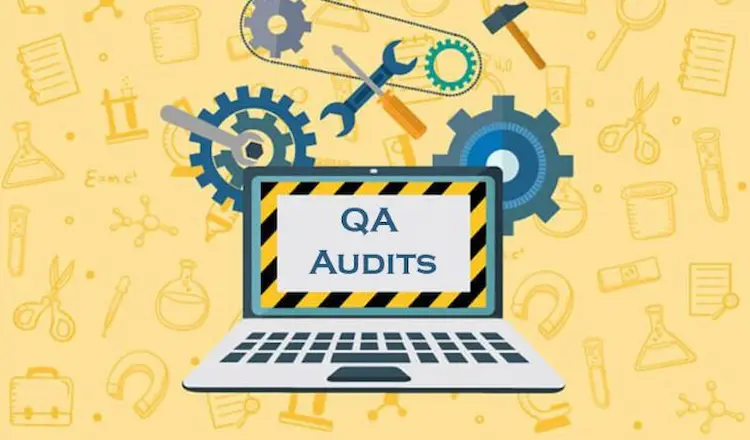Quality assurance (QA) is invaluable in ensuring the highest product quality in software development. When done right, a QA audit can significantly contribute to the project’s success. This audit involves evaluating and examining the existing QA procedures, documents, and staff performance to see if standards and company guidelines are met.
Here, we will look at the ten best practices you should follow to master QA auditing effectively. A well-conducted QA audit becomes crucial because today’s software landscapes are increasingly complex and continuously evolving. It serves as a snapshot of your current performance and a roadmap for future initiatives.
By implementing these best practices, you’ll be better equipped to identify gaps, mitigate risks, and build a robust framework for delivering superior products.

Best Practice #1: Define the Scope Clearly
Before you can even start a QA audit, it’s crucial to explicitly define what you are aiming to achieve with the audit. What processes, departments, or software products are you targeting? By having a clearly outlined scope, you can ensure the audit is focused, making optimal use of time and resources.
It’s essential to have a written document that specifies the audit’s objectives, scope, and the criteria against which the audit findings will be evaluated. This initial planning phase sets the tone for the entire audit process and contributes to its ultimate success or failure. Far too often, audits lose efficacy due to a lack of clear goals or an undefined scope, resulting in scattered efforts that don’t yield meaningful insights.
Establishing a robust initial framework gives your audit the direction it needs to be a valuable exercise. This can involve stakeholder interviews to fine-tune your objectives and a pilot phase to test the viability of your planned procedures. Every minute spent in meticulous planning is a future hour saved in execution and analysis.
Best Practice #2: Gather all Necessary Documents
When it comes to QA auditing, documentation is key. You need to make sure all pertinent records, manuals, reports, checklists, and protocols are collected before you start the audit. Organize these documents in an accessible but secure location.
Having comprehensive documentation at your fingertips makes the auditing process more efficient and ensures you have a holistic understanding of your QA environment.
Best Practice #3: Utilize Expert Teams
The quality of your audit is often directly proportional to the quality of the auditing team. Employ experts with a broad and deep understanding of QA processes and technologies.

The audit should not merely be a box-ticking exercise; it should offer insightful assessments contributing to quality improvement. The auditing team should have specialized skills and experience in the audited domain.
Best Practice #4: Include Stakeholders
It is vital to involve all relevant stakeholders in the audit process, from planning to implementation. This inclusivity ensures that the audit’s outcomes and subsequent recommendations are aligned with company objectives and practical realities, thereby increasing the likelihood of implementation.
Best Practice #5: Be Objective
Objectivity is a cornerstone of effective QA auditing. Instead of subjective opinions or gut feelings, use established metrics and standards as your guiding principles. The absence of objectivity can lead to skewed results that may not accurately reflect the state of your QA processes. Therefore, make every effort to maintain an unbiased perspective throughout the audit.
Best Practice #6: Real-time Monitoring
Modern QA auditing practices benefit greatly from real-time monitoring. Instead of just periodic, manual checks, real-time monitoring can give you an immediate snapshot of ongoing processes, allowing you to identify and address issues as they occur.
This agile approach to auditing enhances responsiveness and reduces lag time in implementing necessary changes.
Best Practice #7: Employee Training
The effectiveness of your audit will be substantially impacted by the level of training your audit team has received. Your team should not only be familiar with QA processes but should also be adept at conducting audits. Implement regular training programs and consider certifications to keep everyone updated on the latest auditing techniques and industry best practices.

Best Practice #8: Risk Assessment
Risk assessment forms a vital part of QA auditing. In addition to auditing existing systems and protocols, the team should identify potential bottlenecks and vulnerabilities.
Categorize these risks based on their severity and potential impact. Knowing what to focus on during the audit can save time and resources while ensuring that crucial issues are noticed.
Best Practice #9: Follow Up
The audit continues when the final report is submitted. To ensure that your audit produces tangible results, following up on all action items identified is critical.
Assign responsible persons and set achievable deadlines for each action item to ensure the necessary changes are made within a reasonable time frame.
Best Practice #10: Continuous Improvement
QA auditing is not a one-off event but a continuous process aimed at ongoing improvement. After each audit:
- Take the time to evaluate what worked well, what did not, and why.
- Use these insights to improve your future audits.
- Establish metrics for measuring the audit’s success and use these as a baseline for continuous improvement.
Conclusion
Incorporating these ten best practices into your QA auditing processes can transform your quality assurance efforts. This is not just about ticking off checklist items but truly enhancing the quality of your products and, by extension, customer satisfaction.
By carefully planning, involving the right people, and adhering to best practices, you can turn QA auditing from a compliance exercise into a strategic tool for continuous improvement.